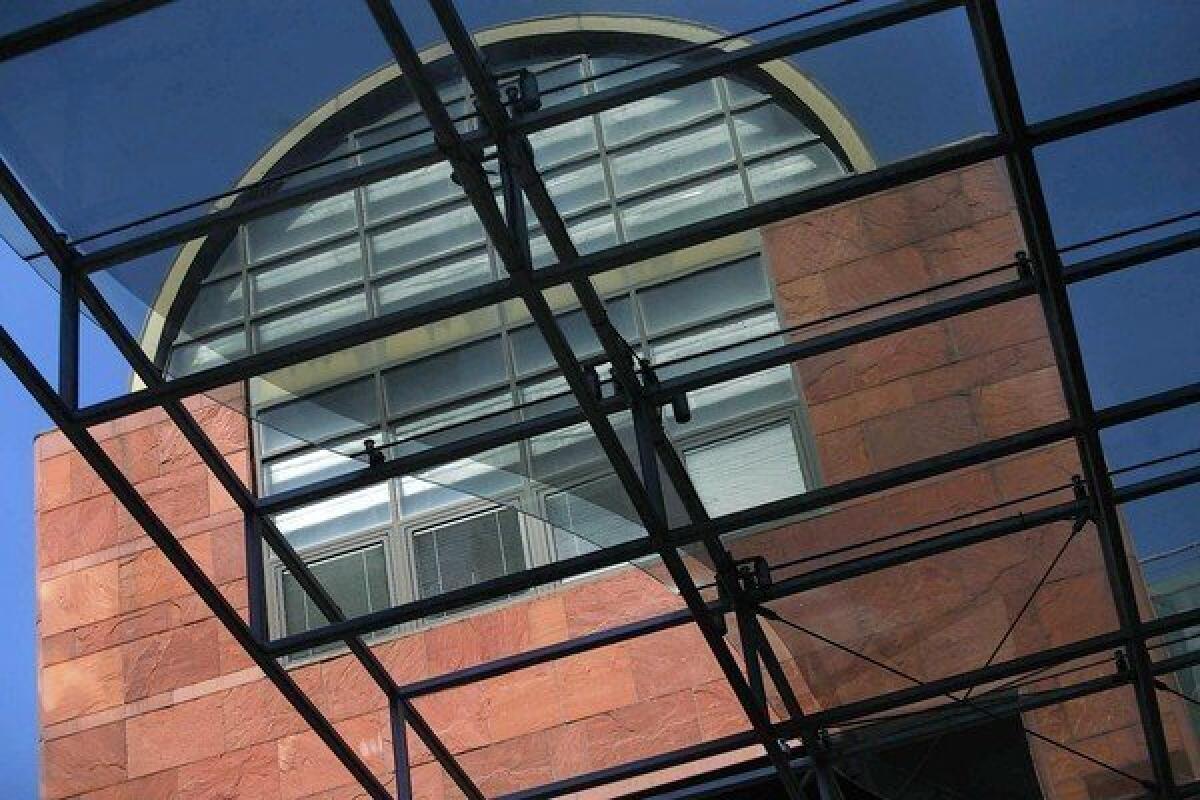MOCA’s board: Deep pockets aren’t a cure-all

The trustees of L.A.’s Museum of Contemporary Art meet around portable tables inside its galleries, because 39 members plus a museum director are too many to fit in its boardroom.
Pooling their money, this eminent, lavishly wealthy group could easily afford to buy everything that’s on the walls and in storage were it for sale — a 6,000-piece collection considered one of the world’s finest troves of post-World War II art.
On the board are five men who made Forbes magazine’s most recent list of the world’s billionaires and the wife of a sixth. Their combined assets come to $24.1 billion, by Forbes’ reckoning.
MOCA: Meet the Board | Meet the billionares | Museum donors’ roll
But this summer, the MOCA board has made headlines with dissension rather than donations — at a time when donations are badly needed, because money to run the museum has become uncomfortably tight.
Eli Broad, the museum’s leading donor, disclosed that MOCA reduced its budget to $14.3 million for the current fiscal year that began July 1.
That would be the museum’s leanest spending since the 1990s, and it means that MOCA has been leapfrogged by UCLA’s Hammer Museum, which is also devoted to contemporary art and plans to spend $17.2 million this fiscal year. Both spend much less than L.A.’s perennial Big Two, the Getty Museum and the Los Angeles County Museum of Art.
Why is this happening at a museum whose board, if so inclined, could splash money into its coffers as exuberantly as Jackson Pollock splashed stringy swirls of paint onto the huge “Number 1, 1949” canvas that was bequeathed to MOCA in 1989?
The answers may be complex. Wealthy people have many options for their philanthropy, and, according to experts on nonprofit board behavior, they can quickly become skittish about giving when controversy breaks out.
MOCA: Meet the Board | Meet the billionares | Museum donors’ roll
And MOCA has been swimming in controversy since late June, when its longtime chief curator, Paul Schimmel, was forced to resign — not by director Jeffrey Deitch but in a meeting at the Broad Foundation office suite in which the MOCA board’s co-chairs, David Johnson and Maria Arena Bell, negotiated the terms of the curator’s exit without informing the full board in advance.
The co-chairs’ original public statement that the parting was “amicable” did not gain much traction. Soon, all four artists on MOCA’s board had resigned — a blow for a museum that proudly distinguishes itself from most others by including artists as trustees.
Contention began to emerge among board members not only over Schimmel’s ouster and Deitch’s exhibition style, which often interweaves art with pop culture, but over broader issues of governance. Some trustees said that Broad and the board’s 10-member executive committee were overstepping their authority and cutting the full board out of the information loop and the decision-making process.
Just after Labor Day, MOCA’s trustees convened in a special board meeting aimed at restoring balance and unity. Several members who previously had voiced their displeasure over recent developments declined to comment afterward, saying everyone had agreed to keep deliberations private. Most of the board has avoided public comment during the upheaval.
Jane Nathanson, a longtime MOCA supporter who resigned from the board in March, said she was put off by how the board operates.
MOCA: Meet the Board | Meet the billionares | Museum donors’ roll
“You don’t have a cohesive board that feels engaged and included at MOCA anymore,” she said. “It sort of became a one-man show there,” with Broad in control. “It’s difficult to maintain engagement on the part of the entire board when the decision-making is limited to a few.”
Nathanson remains on the board of the Los Angeles County Museum of Art, which she said she joined at Broad’s behest in the mid-2000s, when he was funding construction of LACMA’s Broad Contemporary Art Museum.
“The LACMA board meetings are totally engaged,” Nathanson said. “Michael and Terry Semel [the LACMA board’s co-chair] lead, I think, the best board meetings in the city, and I sit on a lot of boards. Everybody feels that their opinion counts.”
Francie Ostrower, a University of Texas professor who studies how cultural organizations function, says her own research on nonprofit boards has shown that such a feeling matters a great deal.
“We found that … one of the strongest things boards can do is be very clear about what’s expected [of members] and hold them to it but also to give opportunities to feel they can participate and make a difference. You can have a gamut — people so dedicated to an organization that they eat, live and breathe it, and others who aren’t going to do that much.”
MOCA: Meet the Board | Meet the billionares | Museum donors’ roll
Carol Weisman, president of Board Builders, a St. Louis-based consultancy for nonprofits, said that two of the most important tasks for trustees are hiring and evaluating (and, if necessary, firing) a chief executive and helping the CEO meet fundraising goals by writing checks and using their social connections to enlist outside support.
The MOCA board’s involvement in Schimmel’s ouster was a departure from the norm, she said: “That’s not their job. It’s the CEO’s job.”
Friction on boards is not necessarily a bad thing, Weisman said, if the debate stays inside the boardroom and is settled without acrimony. “If you lose, you either have to play nice with the group or leave. Ultimately, the board should be speaking with one voice.”
In fundraising, what MOCA minimally can expect from its present board is $5.4 million a year — the sum of the 32 voting members’ annual dues, at $75,000 each, plus the $3 million in exhibition support that Broad, a nonvoting, nondues-paying life trustee, promised annually through 2013 as part of his $30-million bailout of the financially depleted museum nearly four years ago.
MOCA needed his rescue because from 2001 to ’08 the board and former director Jeremy Strick consistently had been unable to balance its budgets.
About half the current trustees are holdovers from that era.
MOCA: Meet the Board | Meet the billionares | Museum donors’ roll
Nineteen have joined since 2009, and attracting them has been important to the museum’s finances as well as its governance. In addition to their dues, new members pay a one-time fee of $250,000 ($150,000 for trustees who live outside Southern California).
But to thrive, nonprofit museums need long-term commitments from people who have the means to go beyond what’s minimally required, and the emotional investment to want to do it.
Who’s on the board
On MOCA’s board, with its assortment of billionaires, the wherewithal is not the issue.
Broad, who has given the most, made his estimated $6.3 billion fortune building homes and selling retirement investment plans. Starting in 2014, his 2,000-work collection of contemporary art will be housed at the $130-million Broad Collection museum under construction across the street from MOCA’s Grand Avenue headquarters.
Two of the board’s billionaires live oversees — London-based diamond merchant Laurence Graff, who last year bought one of Andy Warhol’s “Silver Liz” silk screen portraits of Elizabeth Taylor for $16.3 million at a Christie’s auction, and Ukrainian industrialist Victor Pinchuk. Pinchuk has told reporters he aims to build an exquisite museum of his own in Kiev to replace the less fancy PinchukArtCentre he already has established there.
Among the other billionaires, Steven A. Cohen, who Forbes says is worth $8.3 billion, and Daniel Loeb run investment companies based in Connecticut and New York City.
In a 2006 profile of Cohen, who rarely grants interviews, the Wall Street Journal reported that he had spent $700 million on his art collection, including a Pollock drip painting he bought from David Geffen for $52 million. Cohen’s election to the MOCA board was announced in January, when he was a contender to buy the Los Angeles Dodgers. It’s unclear whether losing out on the baseball team has cooled his interest in L.A. and MOCA.
MOCA: Meet the Board | Meet the billionares | Museum donors’ roll
Loeb, whose estimated fortune is $1.2 billion, has a Southern California grounding. He became interested in contemporary art while growing up in Santa Monica, according to MOCA’s December 2010 announcement of his election to the board, and his brother, Josh Loeb, is a Los Angeles restaurateur.
The New Yorker reported in 2007 that Loeb’s art purchases included about 60 works by the German artist Martin Kippenberger, whose first major retrospective in America was mounted by MOCA in 2008, then traveled to New York’s Museum of Modern Art.
Nancy Marks, a member of the MOCA board’s executive committee, is the wife of Howard Marks, whose L.A.-based hedge fund, Oaktree Capital Management, is a leading creditor in the long-running bankruptcy of Tribune Co., which owns the Los Angeles Times. In 2010, the couple, whose estimated fortune is $1.5 billion, hosted the first installment of “Salons by the Shore,” a three-part series moderated by Deitch in which they, Broad and Peter Morton, the former Hard Rock Cafe owner, opened their beachfront homes for discussions featuring artists Doug Aitken, Urs Fischer and Richard Prince.
A seventh MOCA trustee, Wallis Annenberg, may not be a billionaire herself, but she chairs the $1.5-billion, L.A.-based Annenberg Foundation. Like Broad, this summer’s controversies saw her voicing support for Deitch and MOCA’s current direction. The Annenberg Foundation has given MOCA about $3.5 million since 2007, said its executive director, Leonard Aube.
Annenberg also is on the board of the Los Angeles County Museum of Art, which Aube said has received more than $35 million from the foundation since she became a LACMA trustee in 2002.
There’s also plenty of financial firepower among MOCA trustees who lack a billionaire designation from Forbes.
MOCA: Meet the Board | Meet the billionares | Museum donors’ roll
But trustees’ feelings matter as much as the size of their investment portfolios, says Carroll Joynes, a research fellow at the University of Chicago’s Cultural Policy Center. He studied arts boards’ decision-making as co-author of a recent report, “Set in Stone: Building America’s New Generation of Arts Facilities, 1994-2008.”
Speaking generally because he hasn’t studied MOCA, Joynes said that emotions are a wild card in board behavior, and people who are epitomes of clear thinking in their professional lives can make curious decisions as arts volunteers.
“I have seen pretty remarkable things happen on boards, both good and bad,” he said. “Your tie is emotional and personal, and if you stop having confidence at some level, nobody stops you from stepping back or walking away.”
The big donations that are vital to a large museum such as MOCA will flow “when people get excited and exhilarated and happy,” Joyner said. “But when there’s dissension and disagreement, the flowers close up and they won’t open until the sun shines again.”
MORE:
CRITIC’S PICKS: Fall Arts Preview
TIMELINE: John Cage’s Los Angeles
More to Read
The biggest entertainment stories
Get our big stories about Hollywood, film, television, music, arts, culture and more right in your inbox as soon as they publish.
You may occasionally receive promotional content from the Los Angeles Times.







